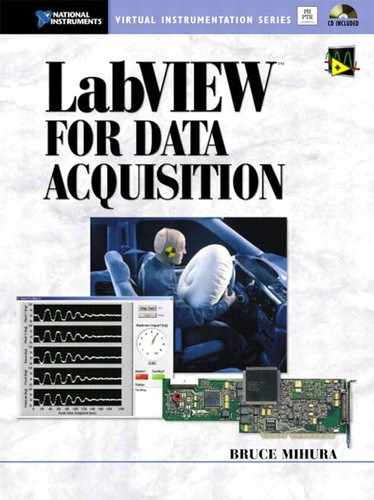Appendix B Top Ten DAQ Problems and Their Solutions
Problems
1. LabVIEW loops run at an irregular rate—some loop iterations take longer than others.
2. Your VI runs too slowly.
3. Delays are seen between analog input waveforms when trying to acquire one right after the other.
4. Digital outputs cannot drive relays.
5. Grounding issues not handled properly.
6. Electrical noise not taken into consideration.
7. Graphing during test slows down acquisition.
8. Third party board difficult to use with LabVIEW.
9. NI’s DAQ device does not respond to anything in LabVIEW.
10. Program or computer crashes.
Solutions
1. Don’t expect perfect LabVIEW loop timing unless you have a real-time operating system or are running LabVIEW RT with appropriate hardware (see Chapter 9).
2. There could be a number of problems, see Chapter 6, Section 6.6.
3. See Chapter 3, Section 3.3.1, Continuous Analog Acquisition (double buffering).
4. Make sure your digital outputs have enough current to drive your relays, plus reverse voltage protection if driving mechanical relays; NI makes many products with built-in relays.
5. See Chapter 2, Section 2.2.1, particularly the DAQ Connections Table (Figure 2–10).
6. See Chapter 2, Section 2.3.1.
7. See Chapter 6, Section 6.7.3.
8. Try to find a working LabVIEW driver for this board, or (a more common begrudging solution) buy an appropriate NI board, if available.
9. Many things could be wrong: (a) MAX is not set up correctly—make sure MAX’s test panels work; (b) defective DAQ device—check its fuses, if any; (c) defective user—seek programming help (see Preface).
10. See Chapter 5, Section 5.3.
Please contact me (see Preface) with your top few DAQ problems so I can keep this list accurate for the next book revision.
